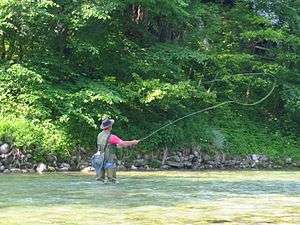Klinkhammer

The Klinkhammer is a popular Emerger used in fly fishing to catch grayling and trout. It is most popular within Europe, but has a growing interest in North America.
History
The Klinkhamer, originally named LT Caddis (light tan), now officially named Klinkhåmer Special, was devised by a Dutch angler Hans van Klinken, in the early 80's to imitate an emerging caddis fly to catch grayling and trout which feed from them as they float in the surface film. This pattern has proven to be an extremely effective fly.
Features
Klinkhamers are different from many other parachute dry flies in that the thorax of the fly is designed to hang down 'through' the surface of the water to imitate an emerging insect.
The abdomen serves as a trigger point which penetrates the surface film, which gets noticed by trout from great distances, even before any resulting surface footprint features.
In all variations of this fly, the abdomen of the fly float is underneath the surface of the water to attract the fish and improve hookups, while the parachute hackle and foam or wing is on or above the surface of the water for visibility and floatation.
External links
- http://www.flyfishersrepublic.com/patterns/klinkhamer-special/ – Notes, Uses, and Tying Instructions for the Klinkhåmer Special

